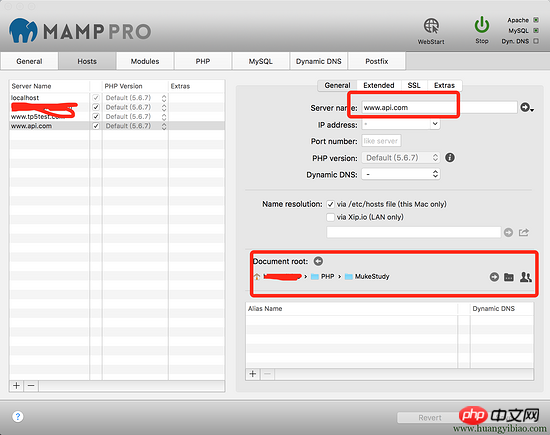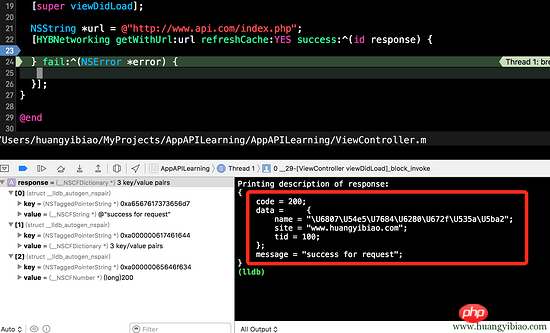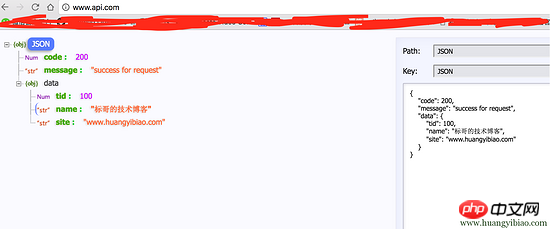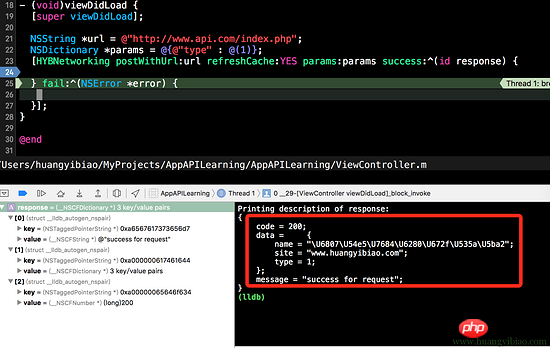How to write a simple App interface using PHP
This article mainly introduces some personal steps and experience summary of using PHP to write a simple App interface. Friends in need can refer to it
This article is the first PHP I tried to write. interface and try app testing in iOS development. Today I will share with you how to write your own interface for testing!
I believe many friends have encountered this problem during development: When will the interface be provided in the background? How do you provide one interface? When will other interfaces be provided? How can our front-end do it without an interface?
Ha ha! After studying this article in college, you can make your own interface to return fixed dead data for testing!
Building a PHP environment
Since the computer I use is a Mac, I recommend you to use the MAMP PRO software, but it is a paid version. I believe everyone who does not want to spend money There will be a way to do it!
MAMP PRO is an integrated environment software that already has apache, mysql, and php, and has the environment to run and parse PHP!
If you don’t want to use an integrated environment, you can build it yourself. Mac comes with apache and PHP environments. You only need to configure it a little before you can use it, and then install mysql!
You can take a look at the simple version configuration: New Mac Configuration PHP Development Environment Tutorial this article.
Start the server
Here is how to start the server, taking the MAMP PRO software as an example. As shown in the picture below, we assume that the service address is www.api.com, and then associate the project directory with this service address. Look at the circled part in the lower right corner of the picture:

After the environment is started, you can directly enter www.api.com in the browser to run it!
Start the GET interface
After our empty project is run for the first time, the file index.php will be automatically generated. We delete the content inside and modify it as follows:
<?php $data = array( 'tid' => 100, 'name' => '标哥的技术博客', 'site' => 'www.huangyibiao.com'); $response = array( 'code' => 200, 'message' => 'success for request', 'data' => $data, ); echojson_encode($response);
The structure we have here is the most common return data structure in daily App development, right? Usually they are status codes, status information and client business data.
PHP is actually very powerful. After declaring the array, you can output json format data through the json_encode function!
iOS Adjust GET Interface
We have a server and have written an interface, so how does the client request and obtain data? Let’s first take a look at the simplest GET request example, which uses the open source library of the HYBNetworking author:
NSString *url = @"http://www.api.com/index.php";
[HYBNetworkinggetWithUrl:urlrefreshCache:YESsuccess:^(id response) {
}fail:^(NSError *error) {
}];Let’s take a look at the response result of the iOS client:

You can see from the response result that it is consistent with what our server interface returns. Look at the effect of accessing it in the browser below:

PHP POST interface
Suppose we require the parameter type to be passed, and it is required to be numeric, used to return different data. When we do interface testing, we can pass this Come and do it, you don’t need to wait for the backend to provide the interface!
<?php
$type = $_POST['type'];
$data = '';
if (isset($type) && is_numeric($type) && $type >= 0) {
if ($type == 1) {
$data = array(
'type' => $type,
'name' => '标哥的技术博客',
'site' => 'www.huangyibiao.com');
} else if ($type == 2) {
$data = array(
'type' => $type,
'name' => '公众号:标哥的技术博客',
'site' => 'weixin search: biaogedejishuboke');
}
$response = array(
'code' => 200,
'message' => 'success for request',
'data' => $data,
);
echojson_encode($response);
return;
}
$response = array(
'code' => 999,
'message' => 'argument error for request',
'data' => $data,
);
echojson_encode($response);iOS calling POST interface
The following is how the iOS client calls the PHP POST interface just written, which uses the HYBNetworking author's This open source library:
NSString *url = @"http://www.api.com/index.php";
NSDictionary *params = @{@"type" : @(1)};
[HYBNetworkingpostWithUrl:urlrefreshCache:YESparams:paramssuccess:^(id response) {
}fail:^(NSError *error) {
}];Let’s look at the effect as follows. We can see that the interface data returned by the server has been received and parsed as expected:

The above is the entire content of this article. I hope it will be helpful to everyone's study. For more related content, please pay attention to the PHP Chinese website!
Related recommendations:
Analysis on PHP memory release and garbage collection
About the implementation of using the php message board function
The above is the detailed content of How to write a simple App interface using PHP. For more information, please follow other related articles on the PHP Chinese website!

Hot AI Tools

Undresser.AI Undress
AI-powered app for creating realistic nude photos

AI Clothes Remover
Online AI tool for removing clothes from photos.

Undress AI Tool
Undress images for free

Clothoff.io
AI clothes remover

AI Hentai Generator
Generate AI Hentai for free.

Hot Article

Hot Tools

Notepad++7.3.1
Easy-to-use and free code editor

SublimeText3 Chinese version
Chinese version, very easy to use

Zend Studio 13.0.1
Powerful PHP integrated development environment

Dreamweaver CS6
Visual web development tools

SublimeText3 Mac version
God-level code editing software (SublimeText3)

Hot Topics
 1378
1378
 52
52
 PHP 8.4 Installation and Upgrade guide for Ubuntu and Debian
Dec 24, 2024 pm 04:42 PM
PHP 8.4 Installation and Upgrade guide for Ubuntu and Debian
Dec 24, 2024 pm 04:42 PM
PHP 8.4 brings several new features, security improvements, and performance improvements with healthy amounts of feature deprecations and removals. This guide explains how to install PHP 8.4 or upgrade to PHP 8.4 on Ubuntu, Debian, or their derivati
 How To Set Up Visual Studio Code (VS Code) for PHP Development
Dec 20, 2024 am 11:31 AM
How To Set Up Visual Studio Code (VS Code) for PHP Development
Dec 20, 2024 am 11:31 AM
Visual Studio Code, also known as VS Code, is a free source code editor — or integrated development environment (IDE) — available for all major operating systems. With a large collection of extensions for many programming languages, VS Code can be c
 How do you parse and process HTML/XML in PHP?
Feb 07, 2025 am 11:57 AM
How do you parse and process HTML/XML in PHP?
Feb 07, 2025 am 11:57 AM
This tutorial demonstrates how to efficiently process XML documents using PHP. XML (eXtensible Markup Language) is a versatile text-based markup language designed for both human readability and machine parsing. It's commonly used for data storage an
 7 PHP Functions I Regret I Didn't Know Before
Nov 13, 2024 am 09:42 AM
7 PHP Functions I Regret I Didn't Know Before
Nov 13, 2024 am 09:42 AM
If you are an experienced PHP developer, you might have the feeling that you’ve been there and done that already.You have developed a significant number of applications, debugged millions of lines of code, and tweaked a bunch of scripts to achieve op
 Explain JSON Web Tokens (JWT) and their use case in PHP APIs.
Apr 05, 2025 am 12:04 AM
Explain JSON Web Tokens (JWT) and their use case in PHP APIs.
Apr 05, 2025 am 12:04 AM
JWT is an open standard based on JSON, used to securely transmit information between parties, mainly for identity authentication and information exchange. 1. JWT consists of three parts: Header, Payload and Signature. 2. The working principle of JWT includes three steps: generating JWT, verifying JWT and parsing Payload. 3. When using JWT for authentication in PHP, JWT can be generated and verified, and user role and permission information can be included in advanced usage. 4. Common errors include signature verification failure, token expiration, and payload oversized. Debugging skills include using debugging tools and logging. 5. Performance optimization and best practices include using appropriate signature algorithms, setting validity periods reasonably,
 PHP Program to Count Vowels in a String
Feb 07, 2025 pm 12:12 PM
PHP Program to Count Vowels in a String
Feb 07, 2025 pm 12:12 PM
A string is a sequence of characters, including letters, numbers, and symbols. This tutorial will learn how to calculate the number of vowels in a given string in PHP using different methods. The vowels in English are a, e, i, o, u, and they can be uppercase or lowercase. What is a vowel? Vowels are alphabetic characters that represent a specific pronunciation. There are five vowels in English, including uppercase and lowercase: a, e, i, o, u Example 1 Input: String = "Tutorialspoint" Output: 6 explain The vowels in the string "Tutorialspoint" are u, o, i, a, o, i. There are 6 yuan in total
 Explain late static binding in PHP (static::).
Apr 03, 2025 am 12:04 AM
Explain late static binding in PHP (static::).
Apr 03, 2025 am 12:04 AM
Static binding (static::) implements late static binding (LSB) in PHP, allowing calling classes to be referenced in static contexts rather than defining classes. 1) The parsing process is performed at runtime, 2) Look up the call class in the inheritance relationship, 3) It may bring performance overhead.
 What are PHP magic methods (__construct, __destruct, __call, __get, __set, etc.) and provide use cases?
Apr 03, 2025 am 12:03 AM
What are PHP magic methods (__construct, __destruct, __call, __get, __set, etc.) and provide use cases?
Apr 03, 2025 am 12:03 AM
What are the magic methods of PHP? PHP's magic methods include: 1.\_\_construct, used to initialize objects; 2.\_\_destruct, used to clean up resources; 3.\_\_call, handle non-existent method calls; 4.\_\_get, implement dynamic attribute access; 5.\_\_set, implement dynamic attribute settings. These methods are automatically called in certain situations, improving code flexibility and efficiency.




